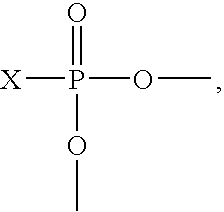Acrylic electrocoat composition and process replacing phosphate pretreatment
- Summary
- Abstract
- Description
- Claims
- Application Information
AI Technical Summary
Benefits of technology
Problems solved by technology
Method used
Image
Examples
examples
Preparation A
Phosphorylated Acrylic Polymer
[0055]A reactor equipped with a reflux condenser and monomer and initiator feed lines is charged with 5.52 parts by weight of toluene. The toluene is heated to reflux. Then simultaneously and uniformly, a monomer mixture (2.10 parts by weight glycidyl methacrylate, 5.32 parts by weight 2-hydroxyethyl methacrylate, 3.28 parts by weight methyl methacrylate, 0.10 parts by weight toluene, 5.72 parts by weight styrene, and 4.77 parts by weight butyl methacrylate) and an initiator mixture (1.045 parts by weight Vazo® 67 and 1.369 parts by weight toluene) are added to the reactor over 3 hours. The temperature is maintained at reflux for an additional 45 minutes after the additions are completed. Then, an initiator mixture (0.211 parts by weight Vazo® 67 and 0.276 parts by weight toluene) is added over 30 minutes and reflux is then maintained for an additional 1.5 hours. The reaction mixture is cooled to about 50° C., then phosphoric acid (75% aque...
preparation b
Grinding Resin Solution Having Tertiary Ammonium Groups
[0056]In accordance with EP 0 505 445 B1, an aqueous-organic grinding resin solution is prepared by reacting, in the first stage, 2598 parts of bisphenol A diglycidyl ether (epoxy equivalent weight (EEW) 188 g / eq), 787 parts of bisphenol A, 603 parts of dodecylphenol, and 206 parts of butyl glycol in a stainless steel reaction vessel in the presence of 4 parts of triphenylphosphine at 130° C. until an EEW (epoxy equivalent weight) of 865 g / eq is reached. In the course of cooling, the batch is diluted with 849 parts of butyl glycol and 1534 parts of D.E.R® 732 (polypropylene glycol diglycidyl ether, DOW Chemical, USA) and is reacted further at 90° C. with 266 parts of 2,2′-aminoethoxyethanol and 212 parts of N,N-dimethylaminopropylamine. After 2 hours, the viscosity of the resin solution is constant (5.3 dPas; 40% in SOLVENON® PM (methoxypropanol, BASF / Germany); cone and plate viscometer at 23° C.). It is diluted with 1512 parts ...
example 1
[0058]A bath was prepared by combining 1096.1 parts Preparation A, 147.3 parts preparation C, and 1256.6 parts deionized water. The water and Preparation A resin emulsion are combined in a container with constant stirring, and Preparation C is added with stirring. The bath solid contents are about 19% by weight.
[0059]Example 1 is coated onto both phosphated and bare cold rolled steel 4-inch-by-6-inch test panels at about 225 volts in the Example 1 bath at bath temperatures from 88-98° F. (31-36.7° C.) for 2.2 minutes and the coated panels are baked for 28 minutes at 350° F. (177° C.). The deposited, cured coating layer has a filmbuild of about 0.8 mil (20 μm).
PUM
| Property | Measurement | Unit |
|---|---|---|
| Percent by mass | aaaaa | aaaaa |
| Percent by mass | aaaaa | aaaaa |
| Equivalent mass | aaaaa | aaaaa |
Abstract
Description
Claims
Application Information
 Login to View More
Login to View More - R&D
- Intellectual Property
- Life Sciences
- Materials
- Tech Scout
- Unparalleled Data Quality
- Higher Quality Content
- 60% Fewer Hallucinations
Browse by: Latest US Patents, China's latest patents, Technical Efficacy Thesaurus, Application Domain, Technology Topic, Popular Technical Reports.
© 2025 PatSnap. All rights reserved.Legal|Privacy policy|Modern Slavery Act Transparency Statement|Sitemap|About US| Contact US: help@patsnap.com



